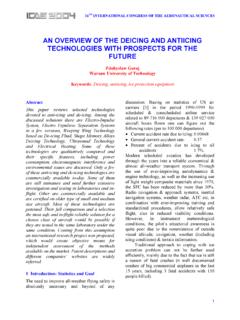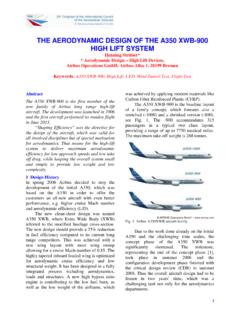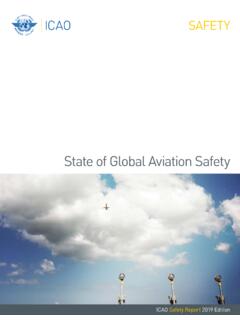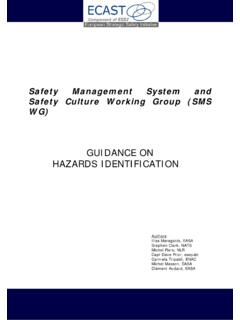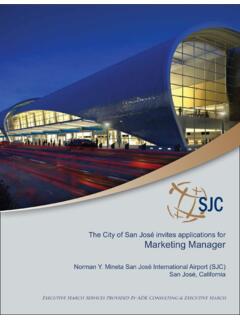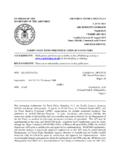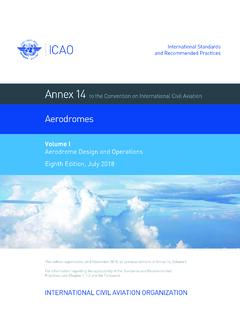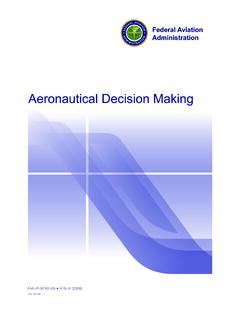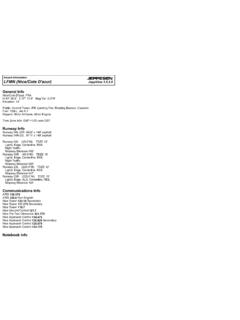Transcription of An Overview of the De-Icing and Anti-icing Technologies ...
1 24TH INTERNATIONAL CONGRESS OF THE AERONAUTICAL SCIENCES 1 Abstract This paper reviews selected Technologies devoted to Anti-icing and De-Icing . Among the discussed solutions there are Electro-Impulse System, Electro_Expulsive Separation Systems in a few versions, Weeping Wing Technology based on De-Icing Fluid, Shape Memory Alloys Deicing Technology, Ultrasound Technology and Electrical Heating. Some of these Technologies are qualitatively compared and their specific features, including power consumption, electromagnetic interference and environmental issues are discussed. Only a few of these Anti-icing and De-Icing Technologies are commercially available to-day.
2 Some of them are still immature and need further extensive investigation and testing in laboratories and in-flight. Other are commercially available and are certified on older type of small and medium size aircraft. Most of these Technologies are patented. Their full comparison and a selection the most safe and in-flight reliable solution for a chosen class of aircraft would be possible if they are tested in the same laboratory under the same condition. Coming from this assumption an international research project was proposed, which would create objective means for independent assessment of the methods available on the market. Patent descriptions and different companies websites are widely referred.
3 1 Introduction: Statistics and Goal The need to improve all-weather flying safety is absolutely necessary and beyond of any discussion. Basing on statistics of US air carriers [1] in the period 1990-1999 for scheduled & nonscheduled airline service related to 89 716 000 departures & 139 027 000 aircraft hours flown one can figure out the following rates (per to 100 000 departures): Current accident rate due to icing: General current accident rate: Percent of accidents due to icing to all accidents: Modern scheduled aviation has developed through the years into a reliable economical & almost all-weather transport system.
4 Through the use of ever-improving aerodynamics & engine technology, as well as the increasing use of light weight composite materials since 1970, the SFC has been reduced by more than 30%. Radio navigation & approach systems, inertial navigation systems, weather radar, ATC etc, in combination with ever-improving training and standardized procedures, allow relatively safe flight, also in reduced visibility conditions. However, in instrument meteorological conditions, the pilot s situational awareness is quite poor due to the nonexistence of outside visual altitude, navigation, weather (including icing conditions) & terrain information. Traditional approach to coping with ice accretion problem can not be farther used efficiently, mainly due to the fact that ice is still a reason of fatal crashes (6 well documented crashes of big commercial airplanes in the last 15 years, including 3 fatal accidents with 110 people killed).
5 AN Overview OF THE DEICING AND ANTIICINGTECHNOLOGIES WITH PROSPECTS FOR THE FUTURE Zdobyslaw Goraj Warsaw University of Technology Keywords: Deicing, antiicing, ice protection equipment Zdobyslaw Goraj 2 2 Worldwide accident s statistics Unknown orawaiting reports91151086513565200 Flight t a l w i t hknown causesTo t a l0%10%20%30%40%50%60%70%80%67%11 %7%6%4%4%Number of hull-loss accidents Primary cause factors in hull-loss accidents, all airplanes, worldwide commercial Jet fleet, 1990-1999, after Commercial Aviation Safety by Aviation Week, 2001 [1] Controlled flight into terrainLoss of controlMidair collisionIn-flight fireFuel tank explosionOff end on landingOff side on landingHard landingLanded shortGear collapse/fail/upIce/snowFuel management/exhaustionWindshearTakeoff configurationOff side on takeoffRunway incursion vehicle/poepleWing strikeEngine failure/separationGround collisionGround crew injuryBoarding/deboardingTurbulence fatalityMiscellaneous*Fire on groundAircraft structureUnknownRefused takeoff - off endGenerationTo t a lFirstSecondEarly widebodyCurrentTot a lLanding5413449148385 where First Comet 4, 707/720, DC-8, CV-880/990, Caravelle Second 727, Trident, VC-10, BAC 1-11, DC-9, 737-100/200, F-28 Early widebody 747-100/200/300/SP, DC-10, L-1011, A300 Current MD-80, 767, 757.
6 A310, Bae146, A300-600, 737-300/400/500, F-100, A320/319/321, 747-400, MD-11, A340, A330, MD-90, 777, 737NG, 717 SecondFirstEarly per million departures Accident categories by airplane generation, all accidents, worldwide commercial jet operations, 1990-1990 , after Commercial Aviation Safety by Aviation Week, 2001 [1] 3 AN Overview OF THE DEICING AND ANTIICINGTECHNOLOGIES WITH PROSPECTS FOR THE FUTURE2829322143352431337 Loss of control in flightCFIT**CFIT = Controlled Flight Into Terrain In-flight fireMidair collisionFuel tank explosionLandingTakeoff configurationIce/snowFuel exhaustionWind shearRunway incursionMisc. FatalityRTO** **= Refused Takeoff RTO TurbulenceOn groundUnknown050010001500200025002111(5) 1902(29)600469238178(37)139(80)11010091( 5)306532482(223)Number of total accidents: 112 FatalitiesNote: Accidents involving multiple, non-onboard are includedAccidents involving single, non-onboard are excludedTotal Fatalities = 6655 (6464 onboard)1999 fatalities = 361 (onboard) Fatalities by accident categories, fatal accidents, worldwide commercial jet fleet, 1990-1999, [1] An example: ATR-72 accident, Roselawn, Indiana, , 1994, all passengers (72) killed Embraer 120, Monroe, Michigan, , 1997, 29 passengers & crew members killed.
7 3 State-of-the-art in aircraft ice protection Anti-ice aircraft protection should be based on deep knowledge of flight physics, meteorology and icing phenomenon. In the relevant bibliography one can find a lot of books, papers and reports [2-39] describing the methodology of icing research and results obtained from measurements and numerical simulation. A traditional approach to coping with ice includes pneumatic deicing boots (usually used on propeller driven aircraft), thermal anti icing systems (to de-ice wing leading edges & propeller leading edges & engine air intakes), glycol based fluid (usually used to protect wing surfaces & propeller leading edges).
8 All these systems are highly complicated, need a lot of on board power & demand very careful maintenance. Reliability of such systems usually contradicts to the degree of their complexity. It is especially difficult to accommodate all these traditional systems on smaller commercial transport airplane, for example on business jet, where weight of additional equipment & its complexity can be a real obstacle to install these systems on board. An example of the parametrical comparison is presented in Table 1. Table 1 Some features of EMEDS technology [47] compared to traditional Pneumatic Boots Parameter modern technology: EMEDS traditional technology.
9 Pneumatic boots erosion surface metal elastometric surface life life of aircraft months, rather not years, depending on service drag increment no increase measurable increase deice performance ice as thin as cm & no upper limit typically greater than cm Weight equivalent baseline Cost equivalent baseline electric power for 12 m span 25 amp* 28 V DC = kW zero 4 A review of modern Technologies SPEED - Sonic Pulse Electro-Expulsive Deicer The Sonic Pulse Electro-Expulsive Deicer (SPEED) is an acceleration based deicer for aircraft ice protection [41]. The system was developed in collaboration with NASA Lewis and ARPA s SBIR program.
10 SPEED evolved from the Electro-Impulsive deicing (EIDI) concept with a major improvement in the actuator coil and electronics. This is due to a Zdobyslaw Goraj 4 special multiple winding actuator that is seated in the leading edge substructure. As in EIDI, actuator coils are strategically placed behind the leading edge to apply impulsive loads directly to the aircraft skin or outer surface material. The rapid acceleration debonds and sheds ice into the airstream in a very efficient manner (ice layers can be shed as thin as 12 mm). SPEED represents the most technically advanced low power deicing system available. IDI s (Innovative Dynamics Inc.) Icing Onset Sensor (IOS) can be added to the basic system to provide an autonomous mode of operation.




